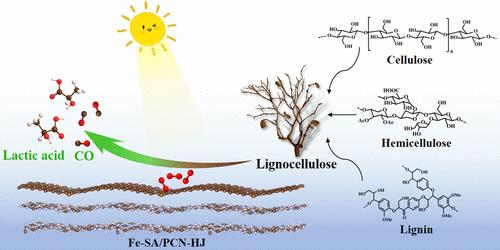当前位置:
X-MOL 学术
›
ACS Catal.
›
论文详情
Our official English website, www.x-mol.net, welcomes your
feedback! (Note: you will need to create a separate account there.)
Photoreforming of Lignocellulose into CO and Lactic Acid over a Single-Atom Fe-Dispersed Order/Disorder Polymeric Carbon Nitride Homojunction
ACS Catalysis ( IF 11.3 ) Pub Date : 2024-11-11 , DOI: 10.1021/acscatal.4c05510 Yanglin Chen, Mei Zheng, Jiajun Sun, Jianzhong Xu, Chao Wu, Jiyuan Liu, Limo He, Shibo Xi, Shuzhou Li, Can Xue
ACS Catalysis ( IF 11.3 ) Pub Date : 2024-11-11 , DOI: 10.1021/acscatal.4c05510 Yanglin Chen, Mei Zheng, Jiajun Sun, Jianzhong Xu, Chao Wu, Jiyuan Liu, Limo He, Shibo Xi, Shuzhou Li, Can Xue

|
Photoreforming lignocellulose into valuable fuels and chemicals represents an environmentally friendly and energy-saving technology. Herein, a single-atom Fe-dispersed order/disorder polymeric carbon nitride homojunction (Fe-SA/PCN-HJ) is constructed for highly efficient photocatalytic reforming of lignocellulose into CO and lactic acid, wherein Fe single atoms are confined to the surface of the PCN-HJ. Experimental investigations and density functional theory (DFT) calculations reveal that the homojunctions and dispersed Fe atoms on the surface greatly improve the separation efficiency and transport of photogenerated charge carriers. As such, driven by the internal electric field across the entire junction, the photoinduced electrons can rapidly migrate from the bulk to the surface, leading to the enrichment of surface electrons at the dispersed Fe–N4 sites. In addition, the Fe–N4 sites optimize the adsorption and activation of molecular oxygen and facilitate electron transfer to the adsorbed molecular oxygen, thereby promoting the formation of reactive oxygen species for lignocellulose photoreforming. Under full spectrum irradiation for 2 h, the Fe-SA/PCN-HJ exhibits an ultrahigh CO generation rate of 92.33 mmol g–1 and yields 136.21 mg of lactic acid by using 900 mg of fructose as the model substrate. Moreover, we have further demonstrated that the Fe-SA/PCN-HJ photocatalyst presents universally applicable capabilities for the photoreforming of various types of lignocellulosic biomass. This work provides an approach for the production of CO and lactic acid through the photoreforming of lignocellulose, which is promising for the production of fuels and valuable chemicals.
中文翻译:

木质纤维素在单原子 Fe 分散序/无序聚合物氮化碳同结上光重整成 CO 和乳酸
将光重质纤维素转化为有价值的燃料和化学品是一种环保和节能的技术。在此,构建了单原子 Fe 分散有序/无序聚合物氮化碳同结 (Fe-SA/PCN-HJ),用于将木质纤维素高效光催化重整为 CO 和乳酸,其中 Fe 单原子被限制在 PCN-HJ 的表面。实验研究和密度泛函理论 (DFT) 计算表明,表面的同结和分散的 Fe 原子大大提高了光生载流子的分离效率和传输。因此,在整个结的内部电场的驱动下,光生电子可以从本体迅速迁移到表面,导致表面电子在分散的 Fe-N4 位点富集。此外,Fe-N4 位点优化了分子氧的吸附和活化,并促进了电子转移到吸附的分子氧上,从而促进了用于木质纤维素光重整的活性氧的形成。在全光谱照射 2 h 下,Fe-SA/PCN-HJ 表现出 92.33 mmol g–1 的超高 CO 生成速率,使用 900 mg 果糖作为模型底物产生 136.21 mg 乳酸。此外,我们进一步证明 Fe-SA/PCN-HJ 光催化剂为各种类型的木质纤维素生物质的光整现在具有普遍适用的能力。这项工作提供了一种通过木质纤维素的光重整生产 CO 和乳酸的方法,这对于生产燃料和有价值的化学品很有前途。
更新日期:2024-11-12
中文翻译:

木质纤维素在单原子 Fe 分散序/无序聚合物氮化碳同结上光重整成 CO 和乳酸
将光重质纤维素转化为有价值的燃料和化学品是一种环保和节能的技术。在此,构建了单原子 Fe 分散有序/无序聚合物氮化碳同结 (Fe-SA/PCN-HJ),用于将木质纤维素高效光催化重整为 CO 和乳酸,其中 Fe 单原子被限制在 PCN-HJ 的表面。实验研究和密度泛函理论 (DFT) 计算表明,表面的同结和分散的 Fe 原子大大提高了光生载流子的分离效率和传输。因此,在整个结的内部电场的驱动下,光生电子可以从本体迅速迁移到表面,导致表面电子在分散的 Fe-N4 位点富集。此外,Fe-N4 位点优化了分子氧的吸附和活化,并促进了电子转移到吸附的分子氧上,从而促进了用于木质纤维素光重整的活性氧的形成。在全光谱照射 2 h 下,Fe-SA/PCN-HJ 表现出 92.33 mmol g–1 的超高 CO 生成速率,使用 900 mg 果糖作为模型底物产生 136.21 mg 乳酸。此外,我们进一步证明 Fe-SA/PCN-HJ 光催化剂为各种类型的木质纤维素生物质的光整现在具有普遍适用的能力。这项工作提供了一种通过木质纤维素的光重整生产 CO 和乳酸的方法,这对于生产燃料和有价值的化学品很有前途。


















































 京公网安备 11010802027423号
京公网安备 11010802027423号